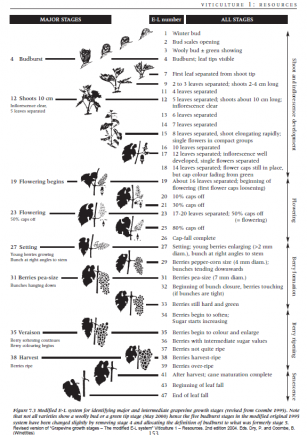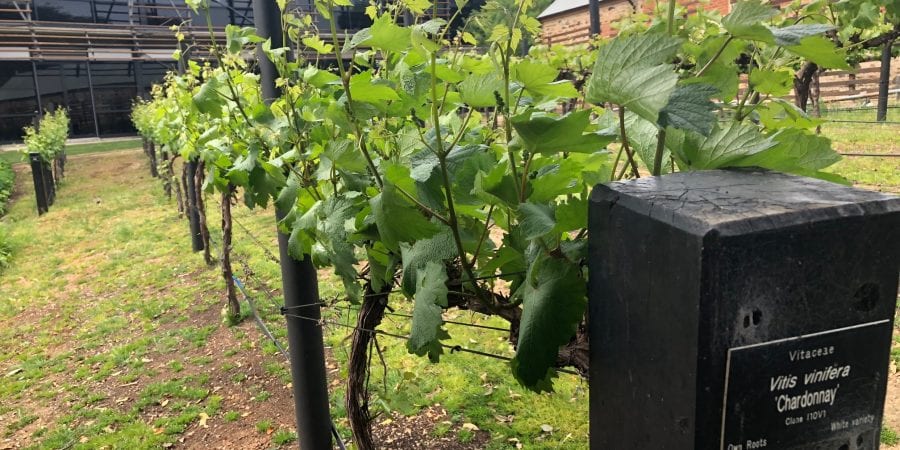We’ve been so busy enjoying the spoils from Rob’s Cellar in recent weeks that I’ve forgotten about the vines!
It doesn’t help much that it still feels very much like winter here in the Hills.
But apparently, it is spring and the grapevines are out there doing their thing. Albeit it, somewhat slower than they might be if we were experiencing some more Spring-like weather!
So what exactly have we missed while I’ve been huddled up next to the fire with a nice glass of 2012 Reserve Shiraz (in my dreams!)?
According to last week’s CropWatch report (annoyingly they come out on Friday afternoons, so we’ll have to put up with week-old news until I brave the cold and go and have a look for myself!), the vines in the Adelaide Hills are currently at the following stages…
Most advanced
E-L 16 10 leaves separated.
(Chardonnay at Macclesfield)

Least advanced
E-L 13 6 leaves separated.
(Sauvignon Blanc at Lenswood and Woodside)

I know I’m at risk of repeating myself (several times I think), but this is definitely worth revisiting for the new comers.
With that in mind, let’s go back and have a look at…
The annual growth cycle of the grapevine
As with all perennial plants, the grapevine follows an annual growth cycle which has eight major stages.
A “perennial” plant is one that grows or blooms over the spring and summer, dies back during the autumn and winter months, and then repeats the cycle from its rootstock the following spring.
1. Budburst (E-L stage 4)
(E-L stage?? What the heck? Don’t worry, I’ll come back to this later)
In Spring (around September/October), the first signs of life occur as the buds begin to break. At this stage, the vines are very susceptible to frosts. Vineyard managers are keeping a VERY close eye on the chilly weather right now. While there are currently no long term predictions of frost, it always pays to have your frost protection ready at this time of year.
2. Shoots 10cm (E-L stage 12)
The bunches are clearly visible at this point. There are five leaves that are visible and open.
3. Flowering begins (E-L stage 19)
The flowers of grapevines are called “perfect flowers”. This means they have both male and female parts and they are able to pollinate themselves without the need for bees.
4. Flowering (E-L stage 23)
We’ll come back to this again in the coming weeks but this is the stage at which 50% of “caps” fall off exposing the reproductive organs of the flower.
(The cap encloses the reproductive organs and other tissues within the flower)
5. Setting (E-L stage 27)
Cap fall is complete and the young berries begin to grow.
6. Berries pea-size (E-L stage 31)
The young berries are now around 7 mm in diameter or about the size of a pea.
7. Veraison (E-L stage 35)
This is when the berries begin to enlarge and change colour. At this stage, the berries are getting sweeter and softer.
8. Harvest (E-L stage 38)
The berries are ripe and ready to harvest!
Loving our blog? Sign up for weekly updates straight to your inbox…
[withwine type=’join-mailing-list’]
What is an E-L stage?

In the science world, we like systems and classifications (well, at least I do!). And it turns out two blokes named Eichhorn and Lorenz did too. So much so that they came up with the first classification of stages for grapevine development (or phenology) in 1977. It has been modified a few times since then but is now commonly referred to as the Modified Eichhorn-Lorenz (E-L) system.
The diagram on the left is the official chart. You can see that the eight major stages are preceded by a number of other stages numbered from 1 to 47.
This chart should make those words from the crop watch report up there make a lot more sense.
So (remembering this news is a week old now), the least advanced vines in the Hills were at growth stage E-L 13. This means that there are 6 separate leaves visible.
And the most advanced vines were at growth stage E- L 16. Which, according to the chart means that there are 10 separate leaves visible.
Surprisingly, the vines are at the same growth stage they were at this time last year. However, this cold snap we’ve had this week has probably slowed them down a bit.
The amount of rain we’ve had so far this season is also causing some headaches regarding vineyard pests and diseases. Growers will be keeping a close eye out for any signs of powdery and downy mildew.
Snails have also been a problem this season. And not just in the vineyard. I found this one trying to get into the Cellar Door. Looks like they’ll go to any length to get to the good stuff!

Christmas Specials
It seems like it’s that time of the year again (although I CAN NOT get my head around it just yet!).
If you haven’t already checked your email, make sure you have a look at our Christmas specials. Add one or two (or even more!) to your November pack or order anytime up until Nov 27th!
